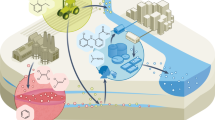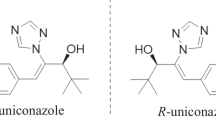Abstract
Assessing the environmental fate of chiral micropollutants such as herbicides is challenging. The complexity of aquatic systems often makes it difficult to obtain hydraulic mass balances, which is a prerequisite when assessing degradation based on concentration data. Elegant alternatives are concentration-independent approaches like compound-specific isotope analysis or enantiospecific concentration analysis. Both detect degradation-induced changes from ratios of molecular species, either isotopologues or enantiomers. A combination of both—enantioselective stable isotope analysis (ESIA)—provides information on 13C/12C ratios for each enantiomer separately. Recently, Badea et al. demonstrated for the first time ESIA for the insecticide α-hexachlorocyclohexane. The present study enlarges the applicability of ESIA to polar herbicides such as phenoxy acids: 4-CPP ((RS)-2-(4-chlorophenoxy)-propionic acid), mecoprop (2-(4-chloro-2-methylphenoxy)-propionic acid), and dichlorprop (2-(2,4-dichlorophenoxy)-propionic acid). Enantioselective gas chromatography–isotope ratio mass spectrometry was accomplished with derivatization prior to analysis. Precise carbon isotope analysis (2σ ≤ 0.5‰) was obtained with ≥7 ng C on column. Microbial degradation of dichlorprop, 2-(2,4-dichlorophenoxy)-propionic acid by Delftia acidovorans MC1 showed pronounced enantiomer fractionation, but no isotope fractionation. In contrast, Badea et al. observed isotope fractionation, but no enantiomeric fractionation. Hence, the two lines of evidence appear to complement each other. They may provide enhanced insight when combined as ESIA.



Similar content being viewed by others
References
Buser HR, Muller MD (1998) Occurrence and transformation reactions of chiral and achiral phenoxyalkanoic acid herbicides in lakes and rivers in Switzerland. Environ Sci Technol 32(5):626–633. doi:10.1021/es970652w
Wong C (2006) Environmental fate processes and biochemical transformations of chiral emerging organic pollutants. Anal Bioanal Chem 386(3):544–558. doi:10.1007/s00216-006-0424-3
Sherwood Lollar B, Slater GF, Sleep B, Witt M, Klecka GM, Harkness M, Spivack J (2001) Stable carbon isotope evidence for intrinsic bioremediation of tetrachloroethene and trichloroethene at Area 6, Dover Air Force Base. Environ Sci Technol 35:261–269
Hunkeler D, Aravena R, Butler BJ (1999) Monitoring microbial dechlorination of tetrachloroethene (PCE) using compound-specific carbon isotope ratios: microcosms and field experiments. Environ Sci Technol 33(16):2733–2738
Richnow HH, Annweiler E, Michaelis W, Meckenstock RU (2003) Microbial in situ degradation of aromatic hydrocarbons in a contaminated aquifer monitored by carbon isotope fractionation. J Contam Hydrol 65(1–2):101–120
Hofstetter TB, Berg M (2011) Assessing transformation processes of organic contaminants by compound-specific stable isotope analysis. TrAC Trends Anal Chem 30(4):618–627
Schmidt TC, Zwank L, Elsner M, Berg M, Meckenstock RU, Haderlein SB (2004) Compound-specific stable isotope analysis of organic contaminants in natural environments: a critical review of the state of the art, prospects, and future challenges. Anal Bioanal Chem 378(2):283–300
Meckenstock RU, Morasch B, Griebler C, Richnow HH (2004) Stable isotope fractionation analysis as a tool to monitor biodegradation in contaminated acquifers. J Contam Hydrol 75(3–4):215–255
Thullner M, Centler F, Richnow H-H, Fischer A (2012) Quantification of organic pollutant degradation in contaminated aquifers using compound specific stable isotope analysis: review of recent developments. Org Geochem 42(12):1440–1460
Elsner M, Zwank L, Hunkeler D, Schwarzenbach RP (2005) A new concept linking observable stable isotope fractionation to transformation pathways of organic pollutants. Environ Sci Technol 39(18):6896–6916
Elsner M (2010) Stable isotope fractionation to investigate natural transformation mechanisms of organic contaminants: principles, prospects and limitations. J Environ Monit 12(11):2005–2031
Elsner M, Jochmann MA, Hofstetter TB, Hunkeler D, Bernstein A, Schmidt TC, Schimmelmann A (2012) Current challenges in compound-specific stable isotope analysis of environmental organic contaminants. Anal Bioanal Chem 403(9):2471–2491. doi:10.1007/s00216-011-5683-y
Meyer AH, Penning H, Elsner M (2009) C and N isotope fractionation suggests similar mechanisms of microbial atrazine transformation despite involvement of different enzymes (AtzA and TrzN). Environ Sci Technol 43(21):8079–8085. doi:10.1021/es9013618
Hartenbach AE, Hofstetter TB, Tentscher PR, Canonica S, Berg M, Schwarzenbach RP (2008) Carbon, hydrogen, and nitrogen isotope fractionation during light-induced transformations of atrazine. Environ Sci Technol 42(21):7751–7756
Penning H, Sorensen SR, Meyer AH, Aamand J, Elsner M (2010) C, N, and H isotope fractionation of the herbicide isoproturon reflects different microbial transformation pathways. Environ Sci Technol 44(7):2372–2378. doi:10.1021/es9031858
Reinnicke S, Simonsen A, Sørensen SR, Aamand J, Elsner M (2012) C and N isotope fractionation during biodegradation of the pesticide metabolite 2,6-dichlorobenzamide (BAM): potential for environmental assessments. Environ Sci Technol 46(3):1447–1454. doi:10.1021/es203660g
Badea S-L, Vogt C, Gehre M, Fischer A, Danet A-F, Richnow H-H (2011) Development of an enantiomer-specific stable carbon isotope analysis (ESIA) method for assessing the fate of alpha-hexachlorocyclohexane in the environment. Rapid Commun Mass Spectrom 25(10):1363–1372. doi:10.1002/rcm.4987
Nittoli T, Curran K, Insaf S, Di-Grandi M, Orlowski M, Chopra R, Agarwal A, Howe AYM, Prashad A, Floyd MB, Johnson B, Sutherland A, Wheless K, Feld B, O’Connell J, Mansour TS, Bloom J (2007) Identification of anthranilic acid derivatives as a novel class of allosteric inhibitors of hepatitis C NS5B polymerase. J Med Chem 50(9):2108–2116. doi:10.1021/jm701232p
Milosevic N, Qiu S, Elsner M, Einsiedl F, Maier MP, Bensch HKV, Albrechtsen HJ, Bjerg PL (2013) Combined isotope and enantiomer analysis to assess the fate of phenoxy acids in a heterogeneous geologic setting at an old landfill. Water Res 47(2):637–649
Chivall D, Berstan R, Bull ID, Evershed RP (2012) Isotope effects associated with the preparation and methylation of fatty acids by boron trifluoride in methanol for compound-specific stable hydrogen isotope analysis via gas chromatography/thermal conversion/isotope ratio mass spectrometry. Rapid Commun Mass Spectrom 26(10):1232–1240. doi:10.1002/rcm.6188
Reinnicke S, Bernstein A, Elsner M (2010) Small and reproducible isotope effects during methylation with trimethylsulfonium hydroxide (TMSH): a convenient derivatization method for isotope analysis of negatively charged molecules. Anal Chem 82(5):2013–2019. doi:10.1021/ac902750s
Pelz O, Hesse C, Tesar M, Coffin RB, Abraham WR (1998) Development of methods to measure carbon isotope ratios of bacterial biomarkers in the environment. Isotop Environ Health Stud 34(1–2):131–144. doi:10.1080/10256019808036364, Taylor & Francis
Silfer JA, Engel MH, Macko SA, Jumeau EJ (1991) Stable carbon isotope analysis of amino acid enantiomers by conventional isotope ratio mass spectrometry and combined gas chromatography/isotope ratio mass spectrometry. Anal Chem 63(4):370–374
Muller RH, Hoffmann D (2006) Uptake kinetics of 2,4-dichlorophenoxyacetate by Delftia acidovorans MC1 and derivative strains: complex characteristics in response to pH and growth substrate. Biosci Biotechnol Biochem 70(7):1642–1654. doi:10.1271/bbb.60011
Hübschmann H-J (2001) Handbook of GC/MS, vol 1. Wiley-VCH Verlag GmbH, Weinheim
Nijenhuis I, Andert J, Beck K, Kastner M, Diekert G, Richnow HH (2005) Stable isotope fractionation of tetrachloroethene during reductive dechlorination by Sulfurospirillum multivorans and Desulfitobacterium sp. Strain PCE-S and abiotic reactions with cyanocobalamin. Appl Environ Microbiol 71(7):3413–3419
Zipper C, Fleischmann T, Kohler HPE (1999) Aerobic biodegradation of chiral phenoxyalkanoic acid derivatives during incubations with activated sludge. FEMS Microbiol Ecol 29(2):197–204. doi:10.1111/j.1574-6941.1999.tb00611.x
Acknowledgments
Michael Maier is financially supported by the German Federal Environmental Foundation (DBU). The study was supported by the Seventh Framework Program (2007–2013) of the European Commission within the GOODWATER Marie Curie Initial Training Network (grant no. 212683). We thank Heide Bensch for her support in the synthesis of S-4-CPP. Two anonymous reviewers are acknowledged for critical comments.
Author information
Authors and Affiliations
Corresponding author
Additional information
Published in the topical collection Isotope Ratio Measurements: New Developments and Applications with guest editors Klaus G. Heumann and Torsten C. Schmidt.
Rights and permissions
About this article
Cite this article
Maier, M.P., Qiu, S. & Elsner, M. Enantioselective stable isotope analysis (ESIA) of polar herbicides. Anal Bioanal Chem 405, 2825–2831 (2013). https://doi.org/10.1007/s00216-013-6745-0
Received:
Revised:
Accepted:
Published:
Issue Date:
DOI: https://doi.org/10.1007/s00216-013-6745-0




